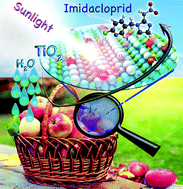Pesticide degradation on solid surfaces: a moisture dependent process governed by the interaction between TiO2 and H2O†
Abstract
Photocatalysis with universality and feasibility has been widely applied to degrade pollutants that mainly exist in gas and liquid systems. However, the photocatalytic degradation of contaminants on solid surfaces is rarely reported. The investigation of the photocatalytic degradation mechanism of pesticide on a solid surface will provide a vital reference for removing pesticide residues on fruit surfaces. Here, we discovered that in situ photocatalytic degradation on solid surface (PDSS) is a moisture dependent process regulated by the interaction between TiO2 and H2O. The interaction mechanism between TiO2 and moisture was revealed by X-ray photoelectron spectroscopy and in situ FT-IR. Meanwhile, we investigated a water layer formed between TiO2 and water on the surface by density functional theory. The photocatalytic degradation process of imidacloprid on the solid surface is proposed. This work explores the H2O impact on photocatalysis in solid surfaces and provides a significant reference for removing pesticide residues in realistic environmental conditions.



 Please wait while we load your content...
Please wait while we load your content...